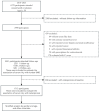Associations of Serum Homocysteine with Bone Mineral Density and Osteoporosis Incidence in Chinese Middle-Aged and Older Adults: A Retrospective Cohort Study
- PMID: 39796626
- PMCID: PMC11723229
- DOI: 10.3390/nu17010192
Associations of Serum Homocysteine with Bone Mineral Density and Osteoporosis Incidence in Chinese Middle-Aged and Older Adults: A Retrospective Cohort Study
Abstract
Objective: This research investigated the prospective association of serum homocysteine with lumbar bone mineral density (BMD) and the risk of osteoporosis in the Chinese population.
Methods: In this cohort, 2551 Chinese individuals aged ≥50 years underwent annual health examinations. Among them, 2551, 1549, and 926 completed two, three, and more than three examinations, respectively. We used generalized estimating equations to analyze the connection between serum homocysteine and lumbar BMD. Additionally, we assessed the connection between serum homocysteine and the incidence of osteoporosis using Cox proportional hazard models. Subgroup analyses based on covariates were performed to identify important at-risk populations.
Results: Participants with higher homocysteine levels showed decreased lumbar BMD compared to those with lower homocysteine levels (p-trend < 0.05). Specifically, lumbar BMD decreased by -0.002 (-0.003, -0.001) g/cm2 for every standard deviation increase in log-transformed serum homocysteine. Compared to the lowest quartile of homocysteine levels, lumbar BMD decreased by -0.006 (-0.010, -0.002) g/cm2 in the highest quartile in men. In smokers, lumbar BMD decreased by -0.007 (-0.012, -0.003) g/cm2 in the highest quartile. During the follow-up period, 175 incidences of osteoporosis were recorded. Serum homocysteine was linked to an increased risk of osteoporosis (p-trend < 0.05). Furthermore, for every standard deviation rise in log-transformed homocysteine, the HR for osteoporosis was 1.33 (95% CI, 1.12-1.58).
Conclusions: Elevated homocysteine levels may be responsible for reduced lumbar BMD in middle-aged and older Chinese people, especially men and smokers. In addition, elevated homocysteine levels may be a risk factor for the development of osteoporosis.
Keywords: bone mineral density; homocysteine; osteoporosis; risk factor.
Conflict of interest statement
Authors Mi Shu and Sishi Yang were affiliated with the Yibicom Health Management Center. The other authors state that this research was carried out without any commercial or financial associations that could be perceived as potential conflicts of interest.
Similar articles
-
Elevated baseline CTX levels predict enhanced therapeutic efficacy of zoledronic acid in augmenting lumbar spine bone mineral density among Chinese osteoporosis patients.Osteoporos Int. 2025 Apr;36(4):707-714. doi: 10.1007/s00198-025-07448-7. Epub 2025 Mar 4. Osteoporos Int. 2025. PMID: 40038109
-
Association of serum alkaline phosphatase levels with bone mineral density, osteoporosis prevalence, and mortality in US adults with osteoporosis: evidence from NHANES 2005-2018.Osteoporos Int. 2025 Feb;36(2):283-297. doi: 10.1007/s00198-024-07324-w. Epub 2024 Nov 29. Osteoporos Int. 2025. PMID: 39611944
-
Association of serum neurofilament light chain and bone mineral density in adults.BMC Musculoskelet Disord. 2025 Apr 21;26(1):391. doi: 10.1186/s12891-025-08639-3. BMC Musculoskelet Disord. 2025. PMID: 40259260 Free PMC article.
-
Quantitative CT lumbar spine BMD cutpoint value for classifying osteoporosis among older Chinese men can be the same as that of older Chinese women, both much lower than the value for Caucasians.Skeletal Radiol. 2025 Feb;54(2):193-198. doi: 10.1007/s00256-024-04722-3. Epub 2024 Jun 21. Skeletal Radiol. 2025. PMID: 38902421 Free PMC article. Review.
-
Relationship of homocysteine levels with lumbar spine and femur neck BMD in postmenopausal women.Acta Reumatol Port. 2015 Oct-Dec;40(4):355-62. Acta Reumatol Port. 2015. PMID: 26922199 Review.
References
MeSH terms
Substances
Supplementary concepts
Grants and funding
LinkOut - more resources
Full Text Sources
Medical


